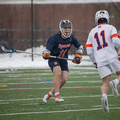Santiago Lopez Hernandez, the head coach at Canterbury, trained Sidibe to play from anywhere on the court. Sidibe learned the traditional post moves a player his height could use and also how to play facing the basket.
Canterbury’s offense was fluid, often interchanging the traditional four and five positions. This allowed Sidibe to drive to the basket from near the 3-point line, run the fast break and sometimes even hit shots from beyond the arc.
A highlight tape from Sidibe’s flaunts him as a stretch four. The first section of the tape, titled “Fast break,” shows Sidibe repeatedly running the length of the floor and flushing dunks or layups. On some plays, he even dribbles by opponents in transition before pulling the ball up close to his body and carrying forward with a step or two toward the basket.
“That’s how I grew up in basketball,” Sidibe said. “Actually moving around, not standing in the zone waiting for somebody to give me the ball then finish it.”
Sidibe was known for his athleticism at St. Benedict’s, too. Taylor recalls Sidibe’s speed as his most impressive attribute including his ability to recoil on a jump, often tipping in his own missed layups. It’s a skill few big men have, Taylor said.
St. Benedict’s didn’t do any official measurements of speed. Still, Sidibe’s explosiveness was evident in drills. In one exercise, coaches ricocheted the ball off the backboard and players chased after it. The first player to the ball wouldn’t run extra. Sidibe rarely ran.
“He can drive by guys, especially big guys,” Taylor said. “When he catches the ball at the elbow, he’s very quick to the rim.”
Sidibe flashed his abilities sparingly at Syracuse. In his freshman season, he scored 18 points and snagged 16 rebounds in a January game against Pittsburgh. His 28 minutes would remain a career-high across the next two seasons.
“Bourama’s a junior, he’s never played here,” head coach Jim Boeheim said. “Two years he didn’t play. Played one game, two games maybe in two years. So he’s just starting out.”
Sidibe played through pain for all of his first two seasons, he said. Some games, he’d look down the court knowing he couldn’t make it back without lumbering in agony.
Tendonitis often spawns from overuse and is known as jumper’s knee, most often occurring in sports where athletes jump repeatedly on hard surfaces, like basketball, according to the Mayo Clinic.
Sidibe squats every other day now, often doing leg extensions and curls as well. All are meant to strengthen the muscles around his knee. But the best remedy may have come this summer when he returned to Mali for two months and barely touched a basketball.








